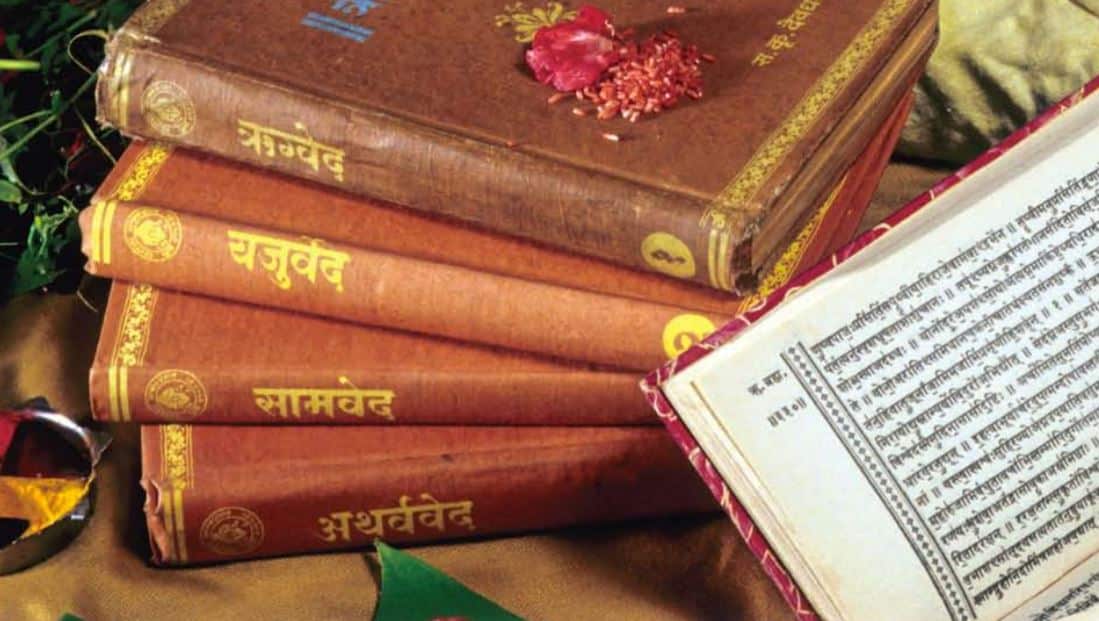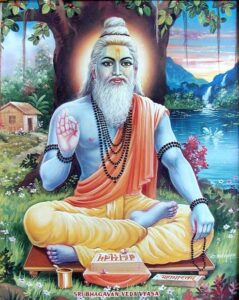Vedas: Four Divine Books
What are Vedas?
The Vedas are ancient sacred texts of Hinduism that are considered to be the oldest holy writings or scriptures of Indian civilization. The word “Veda” is derived from the Sanskrit word “vid,” which means “to know.” Vedas are a great source of eternal knowledge which was once revealed to ancient sages (rishis) and philosophers during their deep states of meditation. These texts are highly admired and cherished by Hindus.

There are four main Vedas
1. Rigveda: The Rigveda is the oldest and most important of the Vedas, consisting of hymns. The hymns praise the gods, seek their blessings, and describe cosmological and philosophical concepts. The Rigveda is the foundation of Hindu religious thought and serves as a source of knowledge about ancient Indian society, culture, rituals, and beliefs.

2. Samaveda: The Samaveda consists of chants (saman) derived from the hymns of the Rigveda. These chants are primarily used in rituals involving melodies and are sung during Soma sacrifices. It is organized into two main parts – the Purvarchika (first part) and the Uttararchika (second part). The chants are meant to be sung in specific musical patterns during rituals. The Samaveda highlights the importance of music, melody, and chanting in ancient Vedic rituals. It emphasizes the spiritual and transformative power of sound and vibration.
3. Yajurveda: The Yajurveda provides detailed instructions and mantras for performing various rituals, including offerings to gods and ceremonies for specific purposes. There are two main versions of the Yajurveda – the Krishna Yajurveda and the Shukla Yajurveda. The Krishna Yajurveda is further divided into the Taittiriya and Katha branches, while the Shukla Yajurveda includes the Vajasaneyi Samhita. The Yajurveda is crucial for understanding Vedic rituals, sacrificial practices, and the roles of priests in ancient Indian society. It emphasizes the relationship between humans, gods, and cosmic forces through elaborate ceremonies.
4. Atharvaveda: The Atharvaveda contains hymns, charms, and spells primarily related to healing, protection, and daily life concerns. It includes incantations for curing diseases, ensuring prosperity, averting evil, and promoting well-being. It is divided into 20 books containing hymns attributed to various sages. The content ranges from prayers to natural elements to magical spells for specific purposes. The Atharvaveda reflects a more practical and folkloric aspect of Vedic literature, focusing on everyday human concerns and domestic rituals. It offers insights into ancient Indian beliefs about health, magic, and spirituality.
Each Veda is further divided into four parts
• Samhitas: Collections of hymns and prayers.
• Brahmanas: Ritualistic texts and commentaries on the hymns.
• Aranyakas: Focused texts on rituals, ceremonies, and sacrifices performed in forests.
• Upanishads: Philosophical and mystical teachings on the nature of reality, self, and ultimate truth.
Who was Rishi Ved Vyas?

Rishi Ved Vyas compiled the single, eternal Veda into four separate books he was proudly given the name “Ved Vyas”. Ved means “Knowledge” and Vyas means “Distribution or compilation”.Ved Vyasa was born to Sage Parashara and Satyavati, the daughter of a fisherman. He grew up living in forests and gained knowledge from saints living there.
Why Vedas are formed?
The Vedas were formed to preserve and transmit spiritual and ritual knowledge across generations. They cover a wide range of subjects including hymns dedicated to various deities, rituals for ceremonies and sacrifices (yajnas), cosmology, philosophy, ethics, and meditation practices. The Vedas are written in Vedic Sanskrit and are characterized by their poetic and symbolic language.
Interesting Facts about Rishi Ved Vyas:
Rishi Ved Vyas is also considered to be the author of the epic Mahabharata and is regarded as one of the seven Chiranjivi (immortal beings) in Hinduism.

Here are some key points about Rishi Ved Vyasa:
-
- Birth and Lineage: Ved Vyasa was born to Sage Parashara and Satyavati, the daughter of a fisherman, through a unique circumstance. He was thus named Ved Vyasa because of his ability to divide (vyasa) the Vedas into distinct parts.
- Compilation of Vedas: One of Vyasa’s major contributions is the arrangement and compilation of the Vedas into four parts – Rigveda, Samaveda, Yajurveda, and Atharvaveda. He classified the vast body of Vedic hymns, rituals, and teachings into these categories for better preservation and understanding.
- Mahabharata: Vyasa is traditionally considered the author of the Mahabharata, one of the longest epic poems in the world. He is credited with composing this epic and narrating it to the sage Vaishampayana, who in turn recited it to King Janamejaya.
- Bhagavad Gita: Within the Mahabharata, Vyasa is also attributed to the authorship of the Bhagavad Gita, which is a sacred dialogue between Prince Arjuna and Lord Krishna on the battlefield of Kurukshetra.
- Puranas: Vyasa is also believed to have divided the original Vedas into various branches and composed the eighteen Mahapuranas, which are important mythological and historical texts in Hinduism.
Overall, Rishi Ved Vyasa occupies a central and respected position in Hindu tradition as a scholar, sage, and divine figure responsible for preserving and disseminating sacred knowledge for the benefit of humanity.
FAQ’S
Q1. Who was Rishi Ved Vyas?
A1. Rishi Ved Vyas compiled the single, eternal Veda into four separate books he was proudly given the name “Ved Vyas”. Ved means “Knowledge” and Vyas means “Distribution or compilation”.Ved Vyasa was born to Sage Parashara and Satyavati, the daughter of a fisherman. He grew up living in forests and gained knowledge from saints living there.
Q2. Who was the mother and father of Rishi Ved Vyas?
A2. Ved Vyasa was born to Sage Parashara and Satyavati, the daughter of a fisherman. He grew up living in forests and gained knowledge from saints living there.
Q3. Why is Rishi Ved Vyas famous?
A3. Rishi Ved Vyas is famous for the compilation of one single eternal book of Veda into four different well-organized books, which are popularly known as Rigveda, Samaveda, Yajurveda, and Atharvaveda.
Q4. What are the names of the four eternal Vedas?
A4. There are four main Vedas:
• Rigveda
• Samaveda
• Yajurveda
• Atharvaveda
* To read more such informative data you can check our website :Devdham yatra.




















